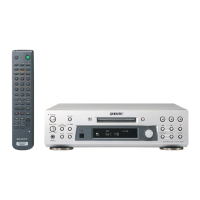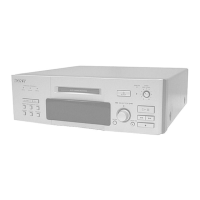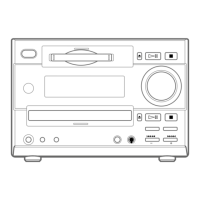21
4-5. Selecting the Test Mode
There are 31 types of the test mode. The group can be switched by rotating the lAMSL knob. Select the group to be used and press
the YES button. After each group is entered, each mode can be switched by rotating the lAMSL .
For the selected contents, refer to the “Group” column in the list.
The group S can support all test modes for servicing. Be careful not to select other groups if not necessary.
• For detailed description of each adjustment mode, refer to Section 5 “Electrical Adjustments”.
For “ERR DP MODE” (C17), refer to the self-diagnosis function of page 2.
• If a different adjustment mode has been selected by mistake, press the MENU/NO button to exit from it.
• The items marked (×) in the mark are not used in servicing, therefore they are not detailed. . If select these modes accidentally, press the
MENU/NO button immediately to exit from it. If the items marked (!) are selected especially, the unit could be operated wrongly by
rewriting the contents of non-volatile memory. Be careful of it.
Display
TEMP CHECK
LDPWR CHECK
EF MO CHECK
EF CD CHECK
FBIAS CHECK
ScurveCHECK
VERIFYMODE
DETRK CHECK
TEMP ADJUS
LDPWR ADJUS
EF MO ADJUS
EF CD ADJUS
FBIAS ADJUS
EEP MODE
ERR DP MODE
ADJ CLEAR
AG Set (MO)
AG Set (CD)
Iop Read
Iop Write
JA555 @@@@@@
CPLAY MODE
CREC MODE
No.
C01
C02
C03
C04
C05
C06
C07
C08
C09
C10
C11
C12
C13
C14
C17
C24
C25
C26
C27
C28
C29
C30
C31
Contents
Temperature compensation offset check
Laser power check
Traverse (MO) check
Traverse (CD) check
Focus bias check
S curve check
Non-volatile memory check
Detrack check
Temperature compensation offset adjustment
Laser power adjustment
Traverse (MO) adjustment
Traverse (CD) adjustment
Focus bias adjustment
Non-volatile memory control
Error history display, clear
Initialization of non-volatile memory of adjustment value
Auto gain output level adjustment (MO)
Auto gain output level adjustment (CD)
IOP data display
IOP data writing
Version display of microprocessor
Continuous playback mode
Continuos recording mode
Mark
(×)
(×)
(×)
(×) (!)
Group (*)
CS
CS
CS
CS
CS
C
C
C
AS
AS
AS
AS
AS
D
S
AS
AS
AS
CS
AS
CS
CASD
CASD
(*) Group
C : Check A : Adjust
S : Service D : Develop

